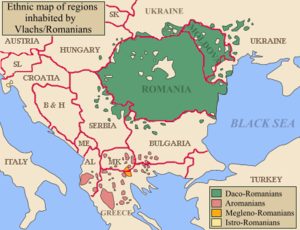Eastern Romance languages
| Eastern Romance | |
|---|---|
| Geographic distribution |
Southeast Europe, Istria |
| Linguistic classification | Indo-European |
| Proto-language | Proto-Romanian |
| Subdivisions | |
| Glottolog | east2714 |

Map of Balkans with regions currently significantly inhabited by Romanians/Vlachs highlighted
|
|
The Eastern Romance languages are a group of Romance languages that developed in Southeast Europe from the local variant of Vulgar Latin. Today, the group consists of Romanian and three other related minor languages, Aromanian, Megleno-Romanian and Istro-Romanian.
Some classifications include also the Italo-Dalmatian languages. When Italian is classified as Western Romance, Dalmatian generally remains in Eastern. However, this article is concerned only with Eastern Romance in the narrow sense, without Italian nor Dalmatian.
The Eastern Romance languages, in their narrow conception, diverged from a common proto-language. They formed until recently a dialect continuum, spread across the Balkan Peninsula and the Carpathian arc. In the words of Latin origin, they share the same phonetic changes, with the exception of very few recent evolutions. So, their classification as separate languages is controversial and is rejected by a majority of romanian linguists.
The Eastern Romance languages are sometimes known as the Vlach languages, being so designated especially by the speakers of Southern-Slavic languages.
An asymmetrical merger of Latin vowels, with /i/ merging with /ē/ and /e/ but /u/ merging with /ū/, sets off Eastern Romance from the symmetrical merger of /u/ with /ō/ and /o/ found in Western Romance. However, while this persists today in only a few isolated dialects in western Basilicata, such as Castelmezzano dialect, as well as Dalmatian and the Romanian languages, there is evidence that it once occurred throughout southern Italy.
Several hundred years after the Roman Empire's dominance of the region, the local form of Vulgar Latin developed into Proto-Romanian, a language which had undergone most of the phonetic and grammatical changes characteristic to modern Romanian with respect to Latin. Subsequently Proto-Romanian diversified and developed into a dialect continuum. Due to foreign invasions that displaced Romance speaking populations and submerged vast areas occupied by intermediate dialects (see Romania in the Dark Ages), surviving Proto-Romanian eventually split into separate varieties:
...
Wikipedia
